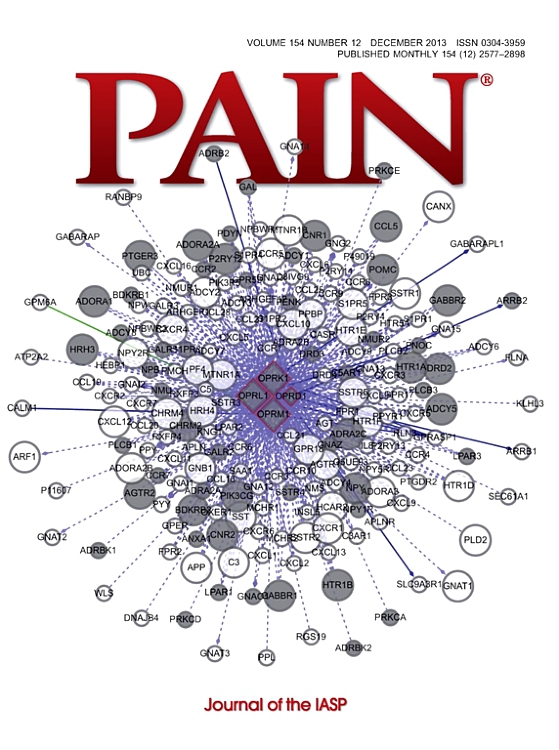新型TRPA1拮抗剂LY3526318的临床前和临床评价。
IF 5.9
1区 医学
Q1 ANESTHESIOLOGY
引用次数: 0
摘要
瞬时受体电位阳离子通道成员A1 (TRPA1)在生理和病理疼痛状态下都与伤害性信号传导密切相关。然而,开发具有适当特性的TRPA1拮抗剂进入临床开发一直是一个挑战。在这里,我们描述了LY3526318的临床前特性和早期临床开发,LY3526318是一种有效的、选择性的、口服生物可利用的TRPA1拮抗剂。体外研究表明,LY3526318可逆地抑制重组TRPA1通道,具有纳摩尔效价,在物种间是保守的。LY3526318还抑制了人和大鼠天然TRPA1通道的功能,包括伤害性背根神经节神经元TRPA1通道。体内研究表明,LY3526318可阻断福尔马林诱发的大鼠退缩行为和慢性弗氏佐剂诱导的冷超敏反应。在这些研究中只使用了雄性大鼠。最初的1期,单次和多次递增剂量研究评估了LY3526318的药代动力学和安全性参数,结果显示,LY3526318的药代动力学特征不理想,导致了LY3526318喷雾干燥分散体(SDD)制剂的开发和研究。当每天给药一次,剂量为250mg时,LY3526318-SDD显示最大作用时间为4小时,12小时的1/2,维持血浆暴露,证明可以参与TRPA1靶点。在所有的1期研究中,不良事件都是短暂的和轻微的。综上所述,LY3526318在体外和体内阻断了TRPA1,在动物模型中抑制了增强伤害感觉的行为迹象,并且在1期临床研究中是安全且耐受性良好的,LY3526318- sdd显示出适当的药代动力学特征,可以推进慢性疼痛患者的概念验证研究。本文章由计算机程序翻译,如有差异,请以英文原文为准。
Preclinical and clinical evaluation of a novel TRPA1 antagonist LY3526318.
The transient receptor potential cation channel member A1 (TRPA1) is heavily implicated in nociceptive signaling in both physiological and pathological pain states. However, it has been challenging to develop TRPA1 antagonists with appropriate properties to advance into clinical development. Herein, we describe the preclinical characterization and early clinical development of LY3526318, a potent, selective, and orally bioavailable TRPA1 antagonist. In vitro studies showed that LY3526318 reversibly inhibited recombinant TRPA1 channels with nanomolar potency that was conserved across species. LY3526318 also inhibited the function of native human and rat TRPA1 channels, including nociceptive dorsal root ganglion neuronal TRPA1 channels. In vivo studies showed that LY3526318 blocked formalin-evoked flinching behaviors and chronic Freund adjuvant-induced cold hypersensitivity in rats. Only male rats were used in these studies. Initial phase 1, single- and multiple-ascending dose studies evaluating pharmacokinetic and safety parameters of LY3526318 revealed a suboptimal pharmacokinetic profile leading to the development and study of a spray-dried dispersion (SDD) formulation of LY3526318. When dosed once daily at 250 mg, LY3526318-SDD showed a tmax of 4 hours and t1/2 of 12 hours, maintaining plasma exposures demonstrated to engage the TRPA1 target. Adverse events were transient and mild across all phase 1 studies. In summary, LY3526318 blocked TRPA1 in vitro and in vivo, inhibited behavioral signs of enhanced nociception in animal models, and was safe and well tolerated in phase 1 clinical studies, with LY3526318-SDD displaying an appropriate pharmacokinetic profile to advance to proof-of-concept studies in patients with chronic pain.
求助全文
通过发布文献求助,成功后即可免费获取论文全文。
去求助
来源期刊

PAIN®
医学-临床神经学
CiteScore
12.50
自引率
8.10%
发文量
242
审稿时长
9 months
期刊介绍:
PAIN® is the official publication of the International Association for the Study of Pain and publishes original research on the nature,mechanisms and treatment of pain.PAIN® provides a forum for the dissemination of research in the basic and clinical sciences of multidisciplinary interest.
 求助内容:
求助内容: 应助结果提醒方式:
应助结果提醒方式:


